| Diese Seite auf Deutsch! |
|
Heath Snails (Geomitridae)Helicellinae Ihering, 1909 |
| Leaf Snails (Hygromiidae) I | Leaf Snails (Hygromiidae) II | Leaf Snails (Hygromiidae) III | Heath Snails (Geomitridae) |
|---|---|---|---|
|
|
|
|
The heath snails, so far, had been placed as a subfamily among the leaf snail family (Hygromiidae). However, due to the results published in a paper in 2015 by Razkin et al., this can no longer be maintained, which is why in modern systematics, such as mentioned in MolluscaBase, the heath snails are placed in another family, the Geomitridae. That family is divided into several subfamilies and consequently tribes (between subfamily and genus). One of them is the subfamily Helicellinae, also containing the Central European heath snail species, as they are described on the present homepage.
Geomitridae C. R. Boettger, 1909
![]() Subfamily Helicellinae Ihering, 1909
Subfamily Helicellinae Ihering, 1909
![]()
![]() Tribe Cernuellini Schileyko, 1991
Tribe Cernuellini Schileyko, 1991
![]()
![]() Genus
Cernuella Schlüter, 1838: Cernuella
virgata
(Da
Costa 1778)
Genus
Cernuella Schlüter, 1838: Cernuella
virgata
(Da
Costa 1778)
![]()
![]() Tribe Helicellini Ihering, 1909
Tribe Helicellini Ihering, 1909
![]()
![]() Genus
Helicella A. Férussac, 1821:
Helicella itala (Linnaeus
1758)
Genus
Helicella A. Férussac, 1821:
Helicella itala (Linnaeus
1758)
![]()
![]() Tribe Helicopsini H. Nordsieck, 1987
Tribe Helicopsini H. Nordsieck, 1987
![]()
![]() Genus
Helicopsis Fitzinger, 1833:
Helicopsis striata (O. F. Müller
1774)
Genus
Helicopsis Fitzinger, 1833:
Helicopsis striata (O. F. Müller
1774)
![]()
![]() Genus
Xerolenta Monterosato, 1892:
Xerolenta obvia (Menke
1828)
Genus
Xerolenta Monterosato, 1892:
Xerolenta obvia (Menke
1828)
Literature:
Eastern or White Heath Snail - Xerolenta obvia (Menke 1828)
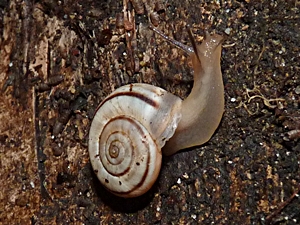 Eastern heath snail (Xerolenta obvia). Picture: Martina Eleveld. |
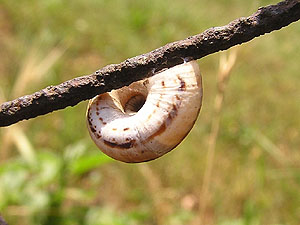 Picture: Robert Nordsieck. |
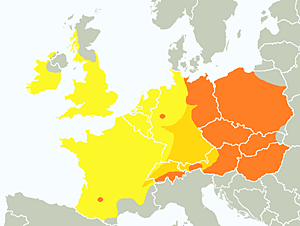 Distribution area of the western (yellow) and eastern (red) heath snail. Orange: Shared distribution area. Source: Kerney et al. (1983). Picture: Robert Nordsieck. |
Description: The shell of the eastern or white heath snail (Xerolenta obvia) is white with a finely striped or ribbed surface. The bands are dark brown to nearly black and often dissolved into spots. The rim of the slightly oblique and rounded aperture is straight and sharp. The shell navel (umbilicus) takes about ¼ of the overall shell diameter, in the last whorl, it becomes wider.
Dimensions: W: 14 - 20 mm; H: 7 - 10 mm; N: 5 - 6.

Habitat and Distribution: The eastern heath snail lives in steppes and on dry hillside slopes, often aestivating in large numbers on vegetation. The species' distribution area spreads from Asia Minor over the eastern and central Balkan Peninsula and the Carpathian countries as far as the southern Baltic Sea coast and to southeastern France. The western border of the species' distribution runs along a line between Heidelberg an Lübeck in Germany.
Like other terrestrial snail species, the white heath snail, as well, is an important indicator organism for their habitat's quality. Contrary to the idea that snails generally need a lot of moisture, especially the heath snails are rather fond of dryness and sunlight. Thus, heath snails suffer from the increase of bush and forest habitat in their former dry habitats. In the then developing cooler microclimate the snails cannot survive and go extinct.
Distinction: Xerolenta obvia can be distinguished from the following species by its narrower navel and the broader ultimate whorl, not clearly descending towards the aperture.
Western Heath Snail - Helicella itala (Linnaeus 1758)
 Western heath snail (Helicella itala): Asturias, Spain. Photo: Miguel A. Casado (iNaturalist). |
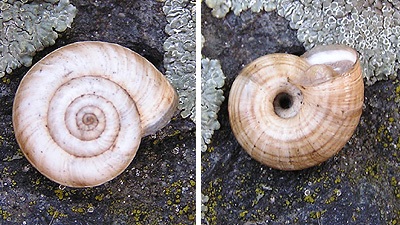 Western heath snail (Helicella itala). Photo: Robert Nordsieck. |
Description: The shell of the western heath snail (Helicella itala) is coloured in a yellowish tone and displays brownish bands that are not that pronounced as in the former species. The shell spire is flatly conical; the shell aperture is oblique and transversally oval. Laterally and basally, the aperture rim is widened. The shell's navel (umbilicus) is perspective, taking about one third of the shell's diameter. Thus, it is wider than in the former species.
Dimensions: W: 9 - 25 mm; H: 5 - 12 mm; N: 5½ - 6½.

Habitat and Distribution: Contrary to the eastern heath snail, the western heath snail is more in need of moist habitats. Its distribution area spreads over all of Western Europe, in the North as far as southern Scandinavia, in the East as far as Central Germany and western Lower Austria.
Distinction: The maritime garden snail is noticeably more spherical in shape than the domestic heath snail species. Helicella itala, however, can be confounded with Cernuella neglecta, which partly occurs in the same habitats in Germany. Helicella itala, though, has a wider umbilicus, a flatter upper side and a less rounded aperture.
Apart from other snail species, heath snail species like Helicella itala, as well, can be the intermediate host of the lesser liver fluke, Dicrocoelium lanceolatum.
Maritime Garden Snail - Cernuella virgata (Da Costa 1778)
 Maritime garden snail (Cernuella virgata). Breitenlee, Vienna. |
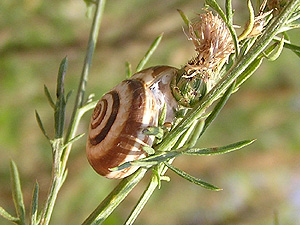 Photos: Robert Nordsieck. |
 Maritime garden snail (Cernuella virgata): Balliang, Victoria, Australia. Photo: Cathy Powers (iNaturalist). |
Description: The maritime garden snail or Mediterranean heath snail is more spherical in shape than the former species. The spire is high and slightly arched; the shell surface is irregularly ribbed. The aperture is rounded to a circular shape, the shell navel (umbilicus) is narrow and often covered by the columellar lip. Colour and shell pattern of the species are quite variable: The shell can be whitish or reddish yellow, usually with dark brown bands, which can be broken or dissolved into spots.
Dimensions: W: 8 - 25 mm; H: 6 - 19 mm; N: 5 - 7.

Habitat and Distribution: The maritime garden snail lives in dry biotopes, for example in dune landscapes near the coast. The species' distribution area encompasses the Mediterranean without the Levantine coasts, as well as the Atlantic coasts as far as the Netherlands, including the British Isles.
In a large part of its distribution area the maritime garden snail is rather frequent. Possibly it was introduced to Britannia during the Roman period, where it lives on well drained calcareous soils. While it is frequent in the South and East of England, it has only been introduced in northern Britain and Ireland (around Dublin) in recent time and there is constantly spreading.
The specimens displayed in the photos on the right, however, come from a location in Vienna, Austria, where they had been introduced in a derelict heap of railway rubble (ruderal area). In Germany, too, the maritime garden snail has been introduced in fallow industrial areas, for example in the Ruhr Area and in Schleswig-Holstein.
Striped Heath Snail - Helicopsis striata (O. F. Müller 1774)
 Striped heath snail (Helicopsis striata): Burgenland, Austria. Photo: Alexander Mrkvicka (iNaturalist). |
Description: The striped heath snail has a whitish shell displaying dark and broken bands. The shell's characteristic surface is coarsely and irregularly ribbed. single shell whorls are flattened on the upper side, but rounded on the lateral part. The suture between the whorls is moderately deep and the ultimate whorl descends slightly towards the aperture. The aperture is rounded and can display a weak apertural lip on the inside. The shell navel (umbilicus) is moderately wide (ca. 1,5 mm) and can cover one sixth of the shell's overall diameter.
 Striped heath snail (Helicopsis striata austriaca). Photo: © Alexander Mrkvicka, Vienna. |
|
 Habitat of Helicopsis striata austriaca. Photo: © Alexander Mrkvicka, Vienna. |
The striped heath snail is different from similar species in that the umbilicus is narrower than in Trochoidea geyeri, as well as in the shell's surface structure, which in Candidula intersecta is less strongly ribbed. Also, that species has a more strongly developed apertural lip.
![]() More
pictures:
Striped Heath Snail (Helicopsis
striata austriaca).
More
pictures:
Striped Heath Snail (Helicopsis
striata austriaca).
Dimensions: W: 6-9 mm; H: 4.5 - 6.5 mm; N: 4 - 4½.

Habitat and Distribution: The striped heath snail is a steppe-dwelling species living in dry and open habitats and often found on calcareous soil. Usually, Helicopsis striata lives in natural habitats, such as grassland, but also alongside fields.
The striped heath snail is distributed throughout all of Europe between Alsace and the Saar region in the West and Moldavia in the East, as well as Ukraine and Turkey. In an isolated area the species also occurs in Sweden, its most northern location.
Note: There are several subspecies in this species. Apart from
Helicopsis striata striata, those are Helicopis striata austriaca in
Austria and Helicopsis striata hungarica in Hungary. There, those
subspecies are endemic and so they are rather vulnerable to changes in their
environment, especially habitat destruction, often by chemicals used in
agriculture. Since the species has been receding dramatically at its Austrian
and Hungarian locations (for a time, in Austria only one location left was
known), in Austria the species is considered critically endangered (CR)
betrachtet (![]() Threat categories according to IUCN
Red List).
Threat categories according to IUCN
Red List).
Today, the former subspecies Helicopsis striata austriaca is listed as an independent species by MolluscaBase; so, under the species Helicopsis striata, MolluscaBase, apart from the nominate subspecies Helicopsis striata striata, only lists Helicopsis striata hungarica as a subspecies.
Latest Change: 28.09.2025 (Robert Nordsieck).